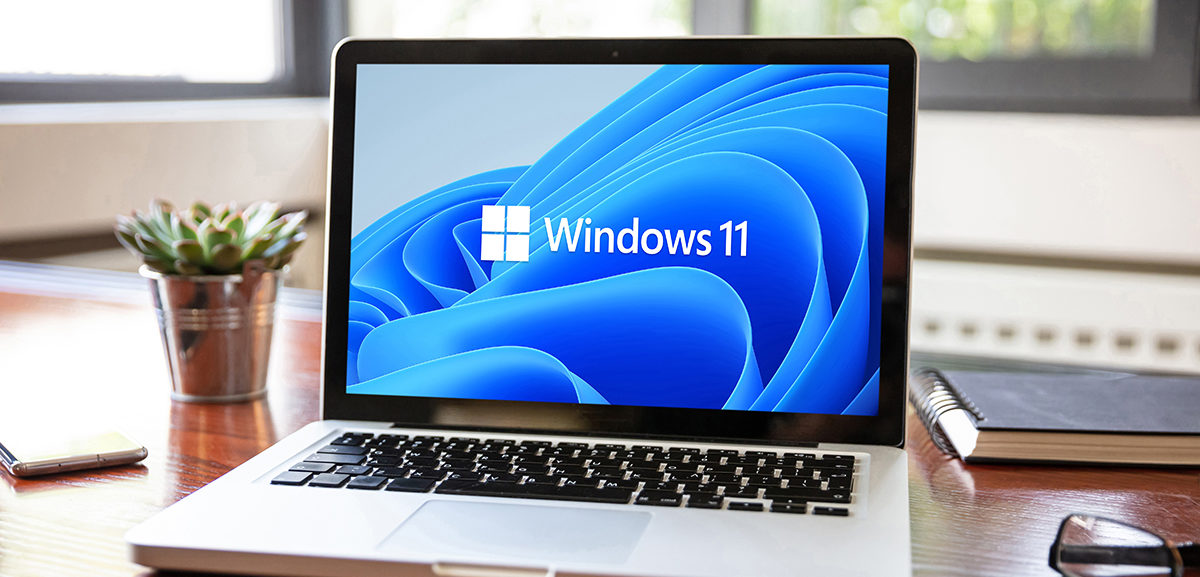
Now the dust has settled on Microsoft’s announcement that Windows 11 is not only real but is very much on the way to being launched, we received a lot of questions about what implications this might have for businesses.
Guided by three of our Microsoft Most Valuable Professionals (MVPs), we answer your questions on the new Windows 11 announcement and what it means for your company in the coming months.
What are our MVP’s first impressions of Windows 11?
Windows 11 has an impressive look and feel, with the fluid design making it seem even slicker. The graphical user interface is aesthetically pleasing and one of the first things a user will notice is the centralised start menu. There’s no longer a left and a right, but three panels.
It certainly feels more polished and efficient. For example, the volume control is now in a single panel, along with the WIFI options. But it still has that Windows identity and individuality, so it almost feels like a Windows 10 update, rather than a complete overhaul.
Why has Microsoft developed Windows 11?
There are a lot of reasons behind the introduction of Windows 11. But a fundamental one, especially considering the timing, seems to be to respond to the needs of businesses operating hybrid working models. And, by extension, supporting their workforces as they prepare for this change.
As we go back into the office, either full-time or partially, there will be people who can’t wait to get back into that physical environment and there will be others who want to continue their current way of working. So, for businesses, a balance needs to be struck.
They will need physical meeting rooms to accommodate remote attendees. And they will need to make sure their tech works, is supported and efficient. For us, this is one of the key reasons why we’re seeing Windows 11 when we believed we would never see a version past Windows 10.
Should your business move to Windows 11 sooner, rather than later?
Some of our clients manage InTune themselves, some are on the Content+Cloud managed desktop service, while some are on Microsoft Managed Desktop. And most have taken a lot of time and effort to move across to Windows 10.
So, a common question will be, should they stop and wait if they are deploying Windows 10, or should they pause until Windows 11 is launched and make a decision then?
If you’re an IT manager and you were just about to start going down the Windows 10 route, our advice would be first of all, not to panic. Windows 10 isn’t going anywhere any time soon. It’s going to be supported until 2025, so there is more than enough time to prepare.
If you’re looking to get ahead, then there’s potentially good news. Microsoft has released the minimum requirements for Windows 11. These include a recent processor and TPM 2.0. So, it’s likely that devices you’ve replaced when moving to Windows 10 will also be compatible with Windows 11.
Your Windows 10 project and your journey to Windows 10 are still very valid as things stand right now. So, we would say don’t think you have to shift gears and change your well-laid plans quickly, because they’ll feed directly into your planning for Windows 11 too.
Should IT managers change their plans to move to Windows 10?
If you have your Windows 10 strategy defined and you know you’re going to adopt Windows AutoPilot and InTune for managed devices and you’re using Azure, the work you’ve already invested in won’t be undone by the introduction of Windows 11.
The familiar management experiences that are in place today, like Microsoft Endpoint Manager, cloud configuration, for example, are all going to still be in play. So, Windows Update for Business, AutoPilot, etc – it’s all going to be supported as you integrate Windows 11 into your estate. So that will all be nice and simple, in theory.
What about your application compatibility?
Microsoft has continued with the model they have for Windows 10 around application compatibility. App Assure, which is part of FastTrack, is a project to ensure your legacy apps are going to continue working with the latest version of Windows. Microsoft will work with you to make sure this is the case. And they have a very good record of this in their documentation. They’re assuring businesses that that will also be the case with Windows 11, which is a real positive.
The key point is that if you’ve been working with Microsoft App Assure in Windows 10, your work won’t be lost or is unlikely to need repeating in the move over to Windows 11.
Microsoft is essentially saying “we will take some of the responsibility for making sure this runs on the new operating system, given that we’ve made it.”
It’s very easy to see if you’re eligible for App Assure with FastTrack. It’s covered by the usual licensing subscriptions you’d expect, Microsoft 365 E3 and upwards.
So, we’d say to businesses, take a look at that and see if you qualify for it within your environment. It’s definitely a good service to be aware of as you plan the journey to move your applications into Windows 10 or Windows 11 – whichever one you’re going to go with.
Are there any changed planned to the way updates are installed?
Updates need to be planned carefully, as there have been cases where applications have not been compatible with the latest versions of Windows. But the model for updating will now be yearly, which a lot of people have been asking for. So, this seems like a good move and good news for businesses, we think.
However, it’s worth bearing in mind that Microsoft is very responsive to user feedback and has been known to change direction to make improvements, so it’s by no means set in stone.
Will Windows 11 and Teams interact differently?
It seems the consumer version of Teams will now be baked into the operating system itself. You’ll see integrations with smarter AI aspects. So, we will have the machine learning and AI elements of Cortana within the product.
For example, you may be able to verbally tell Teams you want to join a meeting or send someone a note to say you’ll be late, which would be built into the Teams client itself.
Because we use Teams for so much now, for example, meetings, communication, screen-sharing, it does need underlying improvements.
And what they’ve done with Windows 11 is move from Angular to ReactJS. So, it will be a native application that is a hybrid web-based app. But it’s going to have some fundamental performance improvements.
If you deploy machines and they have this baked-in client, what does that mean for business users working with enterprise Teams?
There’s not much indication yet of exactly how the components of the business and enterprise Teams will look and feel. But in terms of performance and resource usage, we’ve seen assurance from Microsoft that these things will be ultimately reduced.
This should result in less impact on the processor, less impact on GPU and overall memory usage and ultimately all those things should improve in the client as these things start to be introduced. We’re hoping that these Teams changes will result in these improvements on Windows 10, Mac and Linux clients too.
Will there be any other significant changes?
It’s not yet clear if, like Teams, Microsoft 365 Apps for Enterprise (Office) will be baked into Windows 11. But we’re bound to see some sort of change in direction in line with what we are seeing with Teams.
Some of the changes to Teams may be a clue to this. For example, the mute button is right on the task bar, so we can expect to see much more of that. And much more ability to do modern collaborative working and co-authoring, such as with Teams, for example. Potentially, the same could be on the horizon with Microsoft 365 Apps for Enterprise.
General Microsoft Windows 11 FAQs
What is Windows 11?
Windows 11 is the latest version of Windows’ operating system and was announced by Microsoft on 24th June 2021. As the world and businesses adapt to digital transformation, Microsoft has made improvements to its popular operating system to support this.
When will Windows 11 be released?
Microsoft hasn’t confirmed exactly when Windows 11 will be released but announced that it will be available before the end of 2021. Those eager to try the operating system in the meanwhile can sign up for the Windows Insider programme and access the insider preview by switching channels.
How much is Windows 11?
If your PC runs the most current version of Windows 10 and meets the minimum hardware specifications, you will be able to upgrade. PCs with Windows 11 pre-installed will be available later in 2021.
How do I download and install Windows 11?
You can get an early view of Windows 11 today by enrolling a test Windows 10 machine onto Microsoft’s Windows Insider Programme. You’ll be able to see the current upgrade process from Windows 10 – but remember, Windows 11 isn’t finished yet.
After launch, you’ll be able to plan upgrades to machines enrolled with Microsoft Endpoint Manager (Intune) in a coordinated way and won’t need to download the installation media for deployment.

